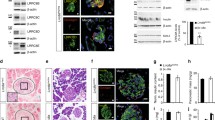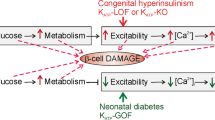Abstract
Recent evidence of beneficial effects of ranolazine (RAN) in type II diabetes motivates interest in the role of the late sodium current (INaL) in glucose-stimulated insulin secretion. In the present work, we characterize INaL and its function in rat INS-1E cells and human islets cells. INaL was identified as steady-state current blocked by 10 μM RAN (IRAN) or 0.5 μM tetrodotoxin (TTX) (ITTX). Veratridine (VERA, 40 μM) was used as INaL enhancer. Baseline INaL was similar between INS-1E and human islet cells. In INS-1E cells, activated by glucose or tolbutamide, TTX or RAN hyperpolarized membrane potential (V m). VERA-induced depolarization was countered by TTX or RAN. ITTX and IRAN reversal potentials were negative to Na+ equilibrium one, but they approached it after Na+ substitution with Li+ or when K+ channels were blocked. This revealed INaL coupling with Na+-activated K+ current (IKNa); expression of IKNa channels (Slick/Slack) was confirmed by transcript analysis and Western blot. RAN or TTX blunted cytosolic Ca2+ response to depolarization. Long-term incubation in high (33 mM) glucose (CHG) constitutively enhanced INaL. VERA immediately increased glucose-stimulated insulin secretion. CHG increased glucose-independent secretion instead and abolished the secretory response to glucose. RAN or TTX countered VERA- and CHG-induced changes in insulin secretion. Our study demonstrated that (1) INaL was expressed in insulin-secreting cells and coupled to IKNa; INaL affected cytosolic Ca2+ but, unless enhanced, barely contributed to glucose-stimulated insulin secretion (GSIS); and (2) sustained hyperglycemic stress enhanced INaL, which contributed to the attending increase of glucose-independent insulin “leak” and GSIS impairment.







Similar content being viewed by others
References
Aoki K, Kosakai K, Yoshino M (2008) Monoaminergic modulation of the Na+-activated K+ channel in Kenyon cells isolated from the mushroom body of the cricket (Gryllus bimaculatus) brain. J Neurophysiol 100:1211–1222
Bansal P, Wang Q (2008) Insulin as a physiological modulator of glucagon secretion. Am J Physiol Endocrinol Metab 295:E751–E761
Barnett DW, Pressel DM, Misler S (1995) Voltage-dependent Na+ and Ca2+ currents in human pancreatic islet beta-cells: evidence for roles in the generation of action potentials and insulin secretion. Pflugers Arch 431:272–282
Belardinelli L, Shryock JC, Fraser H (2006) Inhibition of the late sodium current as a potential cardioprotective principle: effects of the late sodium current inhibitor ranolazine. Heart 92(Suppl 4):iv6–iv14
Bhattacharjee A, Gan L, Kaczmarek LK (2002) Localization of the Slack potassium channel in the rat central nervous system. J Comp Neurol 454:241–254
Bhattacharjee A, von Hehn CA, Mei X, Kaczmarek LK (2005) Localization of the Na+-activated K+ channel Slick in the rat central nervous system. J Comp Neurol 484:80–92
Braun M, Ramracheya R, Bengtsson M, Zhang Q, Karanauskaite J, Partridge C, Johnson PR, Rorsman P (2008) Voltage-gated ion channels in human pancreatic beta-cells: electrophysiological characterization and role in insulin secretion. Diabetes 57:1618–1628
Budelli G, Hage TA, Wei A, Rojas P, Jong YJ, O’Malley K, Salkoff L (2009) Na+-activated K+ channels express a large delayed outward current in neurons during normal physiology. Nat Neurosci 12:745–750
Burashnikov A, Di Diego JM, Zygmunt AC, Belardinelli L, Antzelevitch C (2007) Atrium-selective sodium channel block as a strategy for suppression of atrial fibrillation: differences in sodium channel inactivation between atria and ventricles and the role of ranolazine. Circulation 116:1449–1457
Catterall WA, Goldin AL, Waxman SG (2003) International Union of Pharmacology. XXXIX. Compendium of voltage-gated ion channels: sodium channels. Pharmacol Rev 55:575–578
Chen WJ, Liu XY, Wang LX, Wang YP, Liu XH, Liu LB (2011) Oxidative damage to the endoplasmic reticulum stress pathway of apoptosis-related molecules expression in MIN6 cell. Xi Bao Yu Fen Zi Mian Yi Xue Za Zhi 27:249–252, 256
Dhalla AK, Yang M, Ning Y, Kahlig KM, Krause M, Rajamani S, Belardinelli L (2014) Blockade of Na+ channels in pancreatic alpha-cells has anti-diabetic effects. Diabetes. doi:10.2337/db13-1562
Donatsch P, Lowe DA, Richardson BP, Taylor P (1977) The functional significance of sodium channels in pancreatic beta-cell membranes. J Physiol 267:357–376
Eberhardson M, Grapengiesser E (1999) Role of voltage-dependent Na+ channels for rhythmic Ca2+ signalling in glucose-stimulated mouse pancreatic beta-cells. Cell Signal 11:343–348
Egan TM, Dagan D, Kupper J, Levitan IB (1992) Properties and rundown of sodium-activated potassium channels in rat olfactory bulb neurons. J Neurosci 12:1964–1976
Erickson JR, Pereira L, Wang L, Han G, Ferguson A, Dao K, Copeland RJ, Despa F, Hart GW, Ripplinger CM, Bers DM (2013) Diabetic hyperglycaemia activates CaMKII and arrhythmias by O-linked glycosylation. Nature 502:372–376
Fang YH, Piao L, Hong ZG, Toth PT, Marsboom G, Bache-Wiig P, Rehman J, Archer SL (2012) Therapeutic inhibition of fatty acid oxidation in right ventricular hypertrophy: exploiting Randle’s cycle. J Mol Med-JMM 90:31–43
Gao SB, Wu Y, Lu CX, Guo ZH, Li CH, Ding JP (2008) Slack and Slick KNa channels are required for the depolarizing afterpotential of acutely isolated, medium diameter rat dorsal root ganglion neurons. Acta Pharmacol Sin 29:899–905
Hage TA, Salkoff L (2012) Sodium-activated potassium channels are functionally coupled to persistent sodium currents. J Neurosci 32:2714–2721
Hatlapatka K, Willenborg M, Rustenbeck I (2009) Plasma membrane depolarization as a determinant of the first phase of insulin secretion. Am J Physiol Endocrinol Metab 297:E315–E322
Hirakawa R, El Bizri N, Shryock JC, Belardinelli L, Rajamani S (2012) Block of Na+ currents and suppression of action potentials in embryonic rat dorsal root ganglion neurons by ranolazine. Neuropharmacology 62:2251–2260
Huang YC, Rupnik MS, Karimian N, Herrera PL, Gilon P, Feng ZP, Gaisano HY (2013) In situ electrophysiological examination of pancreatic alpha cells in the streptozotocin-induced diabetes model, revealing the cellular basis of glucagon hypersecretion. Diabetes 62:519–530
Kaneto H, Katakami N, Matsuhisa M, Matsuoka TA (2010) Role of reactive oxygen species in the progression of type 2 diabetes and atherosclerosis. Mediat Inflamm 2010:453892
Kim YC, Sim JH, Kang TM, Suzuki H, Kim SR, Kwon SC, Xu WX, Lee SJ, Kim KW (2007) Sodium-activated potassium current in guinea pig gastric myocytes. J Korean Med Sci 22:57–62
Livak KJ, Schmittgen TD (2001) Analysis of relative gene expression data using real-time quantitative PCR and the 2(−delta delta C(T)) method. Methods 25:402–408
Lu BX, Liu LY, Liao L, Zhang ZH, Mei YA (2005) Inhibition of Na+ channel currents in rat myoblasts by 4-aminopyridine. Toxicol Appl Pharmacol 207:275–282
McCormack JG, Barr RL, Wolff AA, Lopaschuk GD (1996) Ranolazine stimulates glucose oxidation in normoxic, ischemic, and reperfused ischemic rat hearts. Circulation 93:135–142
Mei YA, Wu MM, Huan CL, Sun JT, Zhou HQ, Zhang ZH (2000) 4-Aminopyridine, a specific blocker of K(+) channels, inhibited inward Na(+) current in rat cerebellar granule cells. Brain Res 873:46–53
Meissner HP, Schmelz H (1974) Membrane potential of beta-cells in pancreatic islets. Pflugers Arch 351:195–206
Morrow DA, Scirica BM, Chaitman BR, McGuire DK, Murphy SA, Karwatowska-Prokopczuk E, McCabe CH, Braunwald E (2009) Evaluation of the glycometabolic effects of ranolazine in patients with and without diabetes mellitus in the MERLIN-TIMI 36 randomized controlled trial. Circulation 119:2032–2039
Nesher R, Anteby E, Yedovizky M, Warwar N, Kaiser N, Cerasi E (2002) Beta-cell protein kinases and the dynamics of the insulin response to glucose. Diabetes 51(Suppl 1):S68–S73
Ning Y, Zhen W, Fu Z, Jiang J, Liu D, Belardinelli L, Dhalla AK (2011) Ranolazine increases beta-cell survival and improves glucose homeostasis in low-dose streptozotocin-induced diabetes in mice. J Pharmacol Exp Ther 337:50–58
Pressel DM, Misler S (1990) Sodium channels contribute to action potential generation in canine and human pancreatic islet B cells. J Membr Biol 116:273–280
Qian C, Ma J, Zhang P, Luo A, Wang C, Ren Z, Kong L, Zhang S, Wang X, Wu Y (2012) Resveratrol attenuates the Na(+)-dependent intracellular Ca(2+) overload by inhibiting H(2)O(2)-induced increase in late sodium current in ventricular myocytes. PLoS One 7:e51358
Rajamani S, Shryock JC, Belardinelli L (2008) Block of tetrodotoxin-sensitive, Na(V)1.7 and tetrodotoxin-resistant, Na(V)1.8, Na+ channels by ranolazine. Channels (Austin) 2:449–460
Rajamani S, Shryock JC, Belardinelli L (2008) Rapid kinetic interactions of ranolazine with HERG K+ current. J Cardiovasc Pharmacol 51:581–589
Rosati B, Marchetti P, Crociani O, Lecchi M, Lupi R, Arcangeli A, Olivotto M, Wanke E (2000) Glucose- and arginine-induced insulin secretion by human pancreatic beta-cells: the role of HERG K(+) channels in firing and release. FASEB J 14:2601–2610
Song Y, Shryock JC, Wagner S, Maier LS, Belardinelli L (2006) Blocking late sodium current reduces hydrogen peroxide-induced arrhythmogenic activity and contractile dysfunction. J Pharmacol Exp Ther 318:214–222
Stafstrom CE (2007) Persistent sodium current and its role in epilepsy. Epilepsy Curr 7:15–22
Undrovinas A, Maltsev VA (2008) Late sodium current is a new therapeutic target to improve contractility and rhythm in failing heart. Cardiovasc Hematol Agents Med Chem 6:348–359
Undrovinas NA, Maltsev VA, Belardinelli L, Sabbah HN, Undrovinas A (2010) Late sodium current contributes to diastolic cell Ca2+ accumulation in chronic heart failure. J Physiol Sci 60:245–257
Wagner S, Dybkova N, Rasenack EC, Jacobshagen C, Fabritz L, Kirchhof P, Maier SK, Zhang T, Hasenfuss G, Brown JH, Bers DM et al (2006) Ca/calmodulin-dependent protein kinase II regulates cardiac Na channels. J Clin Invest 116:3127–3138
Wang GK, Calderon J, Wang SY (2008) State- and use-dependent block of muscle Nav1.4 and neuronal Nav1.7 voltage-gated Na+ channel isoforms by ranolazine. Mol Pharmacol 73:940–948
Wang M, Crager M, Pugazhenthi S (2012) Modulation of apoptosis pathways by oxidative stress and autophagy in beta cells. Exp Diabetes Res 2012:647914
Wang Y, Gao L, Li Y, Chen H, Sun Z (2011) Nifedipine protects INS-1 beta-cell from high glucose-induced ER stress and apoptosis. Int J Mol Sci 12:7569–7580
Wang Z, Thurmond DC (2009) Mechanisms of biphasic insulin-granule exocytosis—roles of the cytoskeleton, small GTPases and SNARE proteins. J Cell Sci 122:893–903
Yang B, Desai R, Kaczmarek LK (2007) Slack and Slick K(Na) channels regulate the accuracy of timing of auditory neurons. J Neurosci 27:2617–2627
Yang B, Gribkoff VK, Pan J, Damagnez V, Dworetzky SI, Boissard CG, Bhattacharjee A, Yan Y, Sigworth FJ, Kaczmarek LK (2006) Pharmacological activation and inhibition of Slack (Slo2.2) channels. Neuropharmacology 51:896–906
Zaza A, Belardinelli L, Shryock JC (2008) Pathophysiology and pharmacology of the cardiac “late sodium current”. Pharmacol Ther 119:326–339
Zaza A, Rocchetti M (2013) The late Na+ current—origin and pathophysiological relevance. Cardiovasc Drugs Ther 27:61–68
Zhu HL, Wassall RD, Takai M, Morinaga H, Nomura M, Cunnane TC, Teramoto N (2009) Actions of veratridine on tetrodotoxin-sensitive voltage-gated Na currents, Na1.6, in murine vas deferens myocytes. Br J Pharmacol 157:1483–1493
Acknowledgments
This work was funded by grants from Gilead, Inc. (Fremont, CA) and Network Enabled Drug Design (NEDD from Regione Lombardia) to A. Zaza.
We thank Dr. Claes Wollheim and coworkers (University of Geneva, Switzerland) for kindly supplying the INS-1E cell line. We are also grateful to Drs. Luiz Belardinelli, Arvinder Dhalla, and Sridhar Rajamani of Gilead, Inc. for reading the manuscript and providing constructive comments and suggestions.
Ethical standards
The study was previously reviewed and approved by the Ethical and Scientific Committees of Azienda Ospedaliera-Ospedale Niguarda Ca’ Granda (Milan) and the University of Milano-Bicocca. Human islet donors, or their relatives on behalf, gave written consent for collection of organs and cells for transplant and research, following the statements by the Italian Ministry of Health (art. 23, law n. 91 of 1 April 1999).
Conflict of interest
The study has been partially funded by Gilead, Inc. (Fremont, CA). All authors declare the absence of further conflict of interest.
Author information
Authors and Affiliations
Corresponding author
Electronic supplementary material
Below is the link to the electronic supplementary material.
ESM 1
(DOC 1.05 MB)
Rights and permissions
About this article
Cite this article
Rizzetto, R., Rocchetti, M., Sala, L. et al. Late sodium current (INaL) in pancreatic β-cells. Pflugers Arch - Eur J Physiol 467, 1757–1768 (2015). https://doi.org/10.1007/s00424-014-1613-0
Received:
Revised:
Accepted:
Published:
Issue Date:
DOI: https://doi.org/10.1007/s00424-014-1613-0




